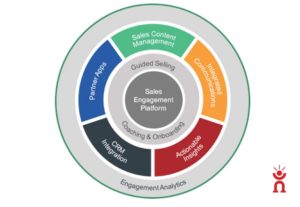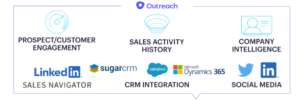Leveraging Your CRM for Sales Engagement
I’m a huge fan of technologies that live up to what they say they do.
When CRM first hit the market, early solutions provided a central location for sales activities and opportunity management, and a central database of client and prospect interactions (assuming CRM was actually being used! – a topic for another post).
Today, many CRM products have expanded to include marketing automation and support desk capabilities (think Sugar Sell, Dynamics 365, or Salesforce). In addition, many add on products have been created to increase the depth and dimension of many CRM solutions.
What’s In It For Me?
However valuable CRM can be, the piece that’s often overlooked is the WIFM – What’s In It For Me? – for salespeople (or for other users who are charged client touches). In the 25 years I’ve been doing this the biggest gap in every CRM solution is addressing what will make the salesperson more successful and yearning to use technology that doesn’t feel like it’s a management only tool for data collection.
While the intent of CRM is to make the company more effective, which it does if properly planned, CRM doesn’t always optimize the salesperson’s day in the life. A salesperson’s biggest gripe! That is, until the Sales Engagement platforms hit the scene.
Sales Engagement Platforms
Sales Engagement Platforms are not bleeding edge or brand new. But they are becoming increasingly relevant because of how sales processes have evolved and how the sales engagement technology is improving. So what is a Sales Engagement software? What the heck does it do?
A Sales Engagement Platform (SEP) is what ensures that every salesperson on your team is executing the right actions at the right time. Think of it as a system of action for sales.
The two software platforms I’ve been studying are definitely not the only tools, but are, in my opinion, the top contenders: Outreach.io and SalesLoft.com.
I find that these platforms are really for proactive companies who are interested in real organic growth and whom want to optimize their sales efforts by optimizing human capacity.
SalesLoft’s, Sean Southworth, says that SalesLoft “is a system of execution behind an organization’s go to market strategy.”
I like to compare SEPs to a superhero analogy. Superheroes have the strength of 20 men. Okay – a little bit of an exaggeration, however what I have found is that a single SDR (sales development representative) with a good SEP can now do what three to five SDRs used to do via a manual step by step in CRM software. This is because even with workflows, a standard CRM simply doesn’t do what a SEP does.
Moreover, a SEP is truly actionable for anyone in sales (SDRs, Account Executives, and Customer Success Managers), and can facilitate both sequencing (Outreach) and cadence (Salesloft) management – though whether you call it a sequence or a cadence it means the same thing.
Benefits of Automating Aspects of Sales
If you don’t already know, a sequence is a series of steps that a SDR will take to find a prospect via an outbound campaign. These steps could include email, calls, and social engagement. A sequence is a multi-step plan that lasts over an automated period. Yes, automated! Meaning the salesperson is able to engage prospects without having to search and manually execute tasks. Because of automation, salespeople are now able to manage 200-500 prospects or clients each. This is much different from a traditional model in which salespeople struggled to manage 100-200 prospects or clients each.
I asked Matt Suliga from Outreach to explain – beyond the automated sequencing – how else Outreach makes his day-to-day tasks easier:
“Not having to remember if I followed up on one of the 100 emails I might send in a day. Being able to start my day by calling/emailing the people who’ve engaged with me versus going down a list of tasks. Not having to go back and forth between meeting times, just having that baked into my email. Taking anything which I write more than twice and turning it into an organized template ready to be inserted, as needed, into any email – Those are the ones that made me go, holy shit my job is going to be so much less of a pain in the ass from a process standpoint, now I can focus on selling.”
This is exactly what SDR’s, AE’s and CSM’s are constantly looking for in their CRM solution, and without this capability user adoption for CRM is a challenge.
Some other quick highlights that a Sales Engagement Platform will provide:
- Sales Dialers
- Meeting and scheduling baked in
- Insights on prospects
- Machine learning
- Team stats – nothing like a bit of competition
- Recording calls for coaching
And more is coming, as AI develops. Imagine AI and machine learning to optimize emails based on best response rates. Or providing insights into who are the most likely prospects to buy your product based on contact profiles. Or BOTs that handle questions and scheduling so that humans can optimize selling time. Superhero status!
Do Sales Engagement Platforms Replace CRM?
Does this replace CRM? Hell no! – Your CRM system provides more dimensions and is your central repository that will provide opportunity management, marketing automation (which is different than what sales engagement provides), customer support and sales operations. Use CRM as your go-to for managing data and one place to “see” 360 degrees of a company or contact.
The two platforms I highlighted, Outreach and Salesloft, integrate with Salesforce. Dynamics is in the works and we at BrainSell have completed a Sugar Sell integration. Integrating SEPs with your CRM will not only help your salespeople spend more time actually selling, but will clean up your prospect lists and help you find the right kinds of clients.
I’ll leave you with a final SEP analogy from Matt Suliga:
“When I think of selling today, I think of trying to make Lasagna without a recipe and adequate kitchen. I can have great cooking utensils, a variety of high-quality ingredients and through trial and error, figure things out. But if I want my Lasagna to be perfect every time, taste amazing on a consistent basis, and always impress my guests, then I need the best recipe and kitchen program to ensure those results happen. That way, I can scale my amazing Lasagna from feeding a handful of guests to a full-service restaurant.”
~ Matt Suliga
Next: Learn about the benefits of integrating Marketing Automation with your CRM.
Having trouble choosing business software for your company? Visit our Contact Us page or email us at [email protected] and we’d be happy to help.

Related Post
Stay in the Loop
Subscribe to get all our latest content sent directly to your inbox!


